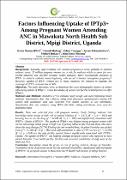| dc.contributor.author | Omona, Kizito | |
| dc.contributor.author | Mulungi, Damali | |
| dc.contributor.author | Twesigye, Edson | |
| dc.contributor.author | Tukamuhabwa, Joram | |
| dc.contributor.author | Rukaari, Medard | |
| dc.contributor.author | Ninsiima, John Bosco | |
| dc.date.accessioned | 2021-03-26T09:53:37Z | |
| dc.date.available | 2021-03-26T09:53:37Z | |
| dc.date.issued | 2021-03 | |
| dc.identifier.other | DOI: 10.47760/cognizance.2021.v01i03.002 | |
| dc.identifier.uri | http://hdl.handle.net/20.500.12280/2632 | |
| dc.description.abstract | Annually, approximately 125 million pregnancies occur globally in malaria
endemic areas. 25 million pregnant women are at risk for malaria which accounts for over
10,000 maternal and 200,000 neonatal deaths annually. WHO recommends initiation of
IPT3+ in malaria endemic areas beginning with second trimester throughout pregnancy?
However, uptakes of IPT3+ remain low in many countries, for instance in Uganda, the
coverage of IPT3+ remains low at 66%.
The study objectives were; to determine the socio-demographic factors of women
influencing uptake of IPTp3+, assess knowledge of women and facility related factors to offer
IPTp3+,
Analytical cross sectional study design was used employing mixed
methods. Quantitative data was collected using semi structured questionnaire among 150
women and qualitative data was collected from health workers as key informants.
Quantitative data was analysed using SPSS v20 while coding and themes were used for
qualitative data.
Data was collected from 150 pregnant women. Study findings indicate that
knowledge about group at high risk of getting Malaria (χ2 = 4.113, df = 1, p = .043) and
knowing how to use the drug (χ2 = 6.590, df =2, p = .037) was significantly associated with
IPTP3+ Uptake of IPTp3+. The uptake of IPTp3+ was highest among pregnant women with
correct knowledge about group at high risk of getting Malaria (46.7%) and those who knew
about the drug dosage (26.7%).Findings further revealed that; the place Fansidar was picked
from (χ2= 15.318, df =4, p = .004) and staff availability to offer IPTP3+service (χ2
= 10.956,
df =2, p =.004) are the only facility related factors significantly associated with IPTP3+
Uptake. The uptake of IPTP3+ was highest amongst pregnant women who reported to have
picked Fansidar from health facility (45.3%) and reported availability of staff most of the
times (42.7%).
Knowledge about the group at risk of getting malaria, dosage of Fansidar,
Availability of the drug stocks at the facility and staff availability significantly affected uptake
of IPTP3+ by pregnant women in Mawokota North Health Sub District in Mpigi District. | en_US |
| dc.language.iso | en | en_US |
| dc.publisher | Cognizance Journal of Multidisciplinary Studies | en_US |
| dc.relation.ispartofseries | Cognizance Journal of Multidisciplinary Studies;Vol.1, Issue.3 | |
| dc.rights | Attribution 3.0 United States | * |
| dc.rights.uri | http://creativecommons.org/licenses/by/3.0/us/ | * |
| dc.subject | Intermittent Presumptive Treatment (IPT) | en_US |
| dc.subject | Malaria | en_US |
| dc.subject | Pregnant mothers | en_US |
| dc.subject | Antenatal care (ANC) | en_US |
| dc.title | Factors Influencing Uptake of IPTp3+ Among Pregnant Women Attending ANC in Mawokota North Health Sub District, Mpigi District, Uganda | en_US |
| dc.type | Article | en_US |



